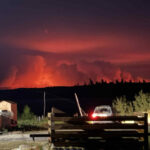The once-bustling streets of Alexandria Bay and Watertown in upstate New York now echo with an unusual quietness this summer, as Canadian license plates—once a common sight—have become increasingly rare. Tourism operators across New York’s northern border communities are reporting a dramatic drop in Canadian visitors, creating what many describe as the most challenging summer season in recent memory.
“We’re down about 30 percent in Canadian traffic compared to last year,” explains Thomas Reynolds, owner of Riverside Gifts in Alexandria Bay, a shop that has catered to cross-border shoppers for over two decades. “I’ve never seen it this slow during peak summer. Usually, Canadians make up nearly half our business from June through August.”
The decline appears to be driven by multiple factors converging at once. The Canadian dollar, hovering around 73 cents to the U.S. dollar, has significantly diminished Canadians’ purchasing power. This economic pressure is compounded by inflation rates that continue to strain household budgets on both sides of the border.
Economic analysts point to additional complications. “We’re seeing a perfect storm of financial constraints for Canadian travelers,” notes Dr. Elaine Winters, economics professor at Queen’s University in Kingston, Ontario. “Beyond currency exchange challenges, increased border wait times and heightened security measures have made day trips and weekend getaways less appealing.”
The impact extends beyond retail. Accommodation providers in traditional Canadian hotspots are feeling the pinch most acutely. The Riverview Hotel in Clayton reports occupancy rates down 25% compared to 2023, with mid-week bookings particularly affected.
For border communities that have historically depended on Canadian tourism, the decline represents more than just a temporary setback. The Thousand Islands Tourism Association estimates that Canadian visitors typically contribute approximately $1.2 billion annually to the regional economy. This year, projections suggest that figure could fall by as much as $300 million.
“This isn’t just about one difficult summer,” warns Jefferson County Economic Development Director Sarah Thompson. “If this becomes a long-term trend, we’re looking at potential permanent closures for businesses that can’t diversify their customer base quickly enough.”
Some businesses are actively pivoting their marketing strategies to attract more American tourists from other regions. The Alexandria Bay Chamber of Commerce has launched an aggressive digital campaign targeting potential visitors from major metropolitan areas within a five-hour drive, including New York City, Buffalo, and Albany.
“We’re highlighting experiences that appeal to domestic travelers who might not have considered the Thousand Islands region before,” explains Chamber President Michael Dawson. “Our message is that you don’t need a passport to enjoy world-class water recreation, historic sites, and family-friendly attractions.”
Despite these efforts, the absence of Canadian visitors remains palpable. Local restaurants report fewer diners during traditional Canadian holiday weekends, and specialty shops that once carried products specifically for Canadian consumers are rethinking their inventory strategies.
While some tourism operators express optimism that Canadian visitors will return when economic conditions improve, others worry that changing travel patterns may represent a more permanent shift. The COVID-19 pandemic already altered cross-border travel habits, and new financial pressures may be reinforcing those changes.
“Canadians have discovered more options within their own borders during the pandemic,” observes travel industry analyst Jennifer Moore. “Combined with financial considerations, we may be witnessing a fundamental realignment of travel patterns rather than a temporary downturn.”
The situation also highlights the interconnected nature of border economies. Local officials on both sides of the border have begun discussions about potential cooperative marketing initiatives and streamlined border procedures that could help revitalize cross-border tourism.
As upstate New York communities adapt to this new reality, the question remains: will Canadian travelers eventually return to their favorite American destinations, or has the combination of economic pressures and changing travel preferences permanently altered the landscape of cross-border tourism in the region?























